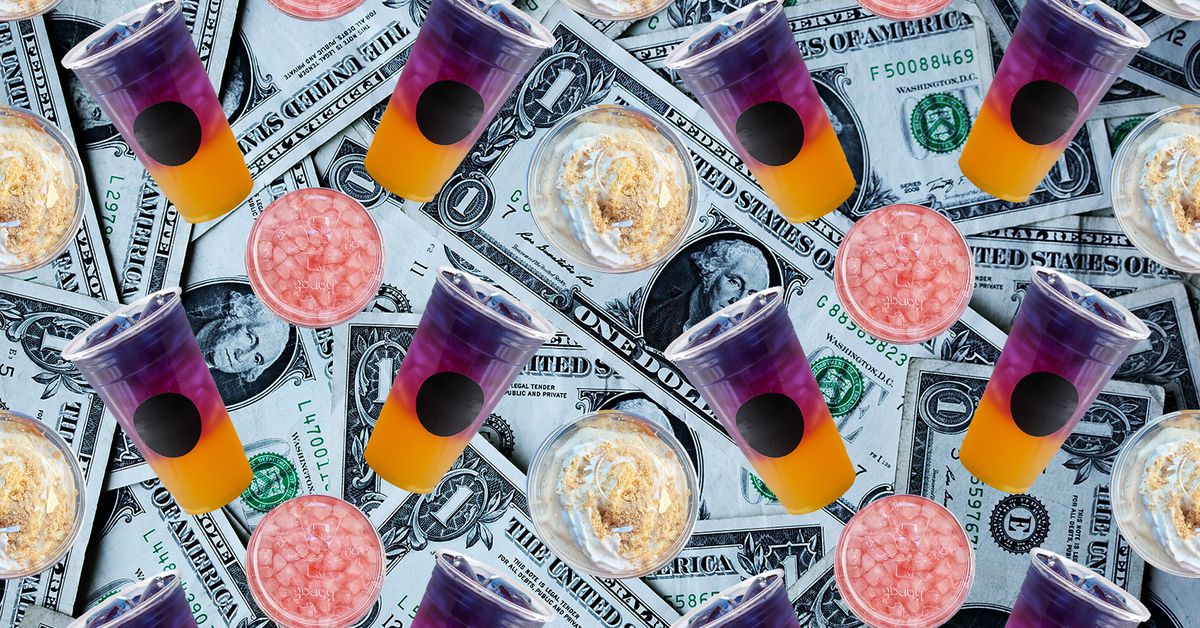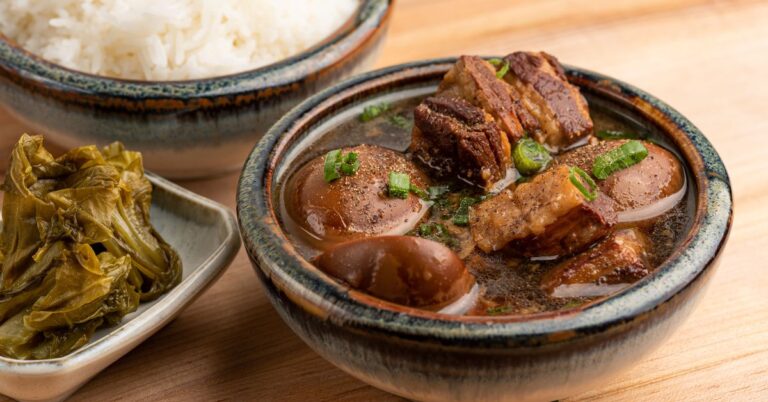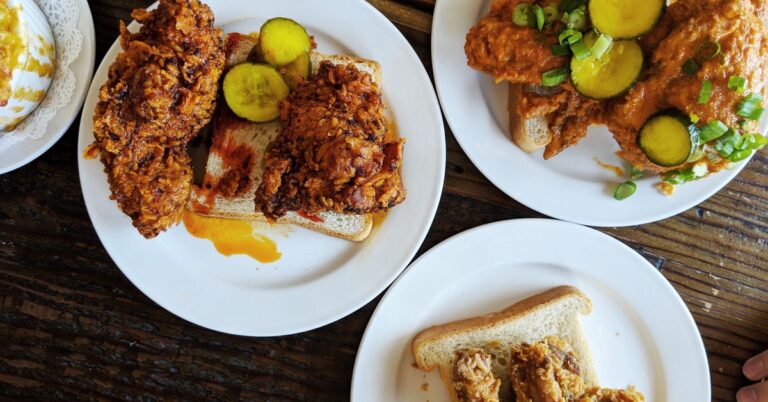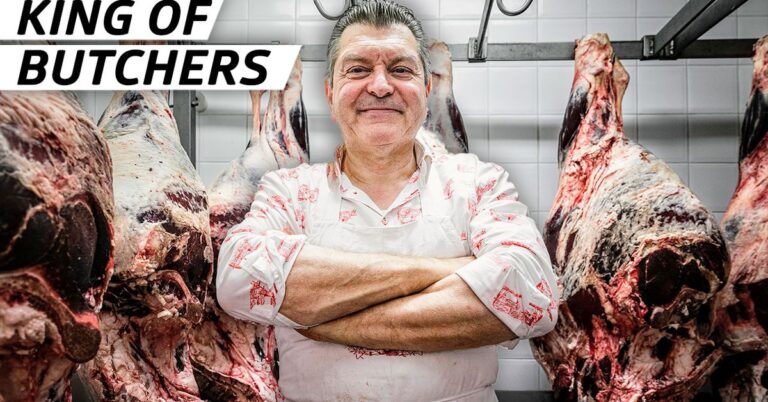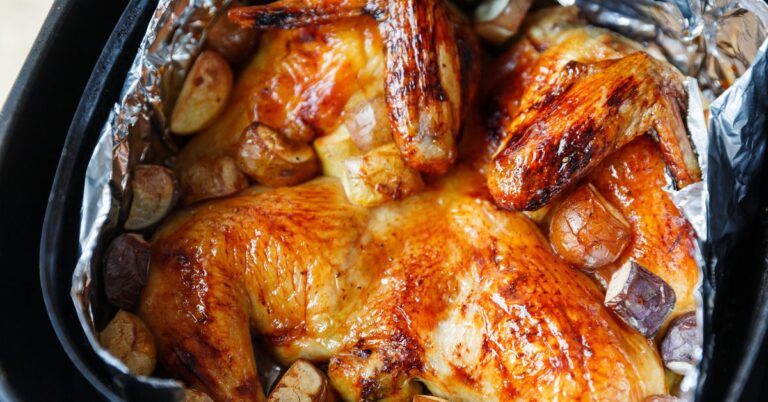The Truth About Herbalife, the Company Behind Loaded Tea Nutrition Clubs
They’re all over Instagram: multicolored beverages in layers of unnaturally bright oranges, greens, and blues, each flavor layered into a cup of ice to show off the vibrant colors. These “loaded teas” — made with tea concentrate and fruit-flavored drink mixes — often boast cheeky names like Bahama Mama or Mermaid and appear alongside promises of zero sugar, few calories, healthy antioxidants, and perhaps most importantly, a big dose of caffeine: #cleanenergy is a frequent accompanying hashtag, which makes sense considering that many loaded teas boast more than 160 milligrams of caffeine — more than double what’s in a cup of coffee.
This rainbow-hued array of drinks is popping up all over the country not as part of a new tea shop chain, but associated with “nutrition clubs” with vague names like Good 2 Go Nutrition or Healthy Life Nutrition. These nutrition clubs aren’t new either, but they are appearing all over small-town America at an impressive clip. In my hometown of 25,000 people — Paris, Texas, which boasts a median household income of around $45,000 per year — there are currently at least five nutrition clubs selling shakes and teas for more than $8 each. What many don’t know, though, is that these shops are almost always making their beverages with ingredients supplied by Herbalife, a multilevel marketing (MLM) company that sells dietary supplements, “nutritional shake mixes,” and protein powders.
Founded in 1980, Herbalife employed the classic MLM model by signing up “independent distributors” who have two responsibilities: to sell the company’s protein powders and nutritional supplements, and to recruit others to become Herbalife distributors. Herbalife has been sued on numerous occasions for that business model, resulting in one $200 million settlement with the Federal Trade Commission in 2016 that required the company to completely revamp its compensation structure — in the settlement announcement, the FTC noted “half of Herbalife ‘Sales Leaders’ earned on average less than $5 a month from product sales.” When reached by Eater, the company declined to answer detailed questions about its business model or provide comment on nutrition clubs.
Like other MLMs, including Lularoe and Doterra, Herbalife has come under increasing scrutiny as the public has become more skeptical. Alongside that rise in distrust — and likely, the FTC ruling that insists that a distributor’s ability to make money “must depend on whether participants sell products, not on whether they can recruit additional distributors to buy products” — comes a seemingly new proliferation of loaded tea-slinging nutrition clubs. These shops use colorful drinks and wellness lingo to lure in new customers who might not even know about the MLM ties. (Also part of these stealth Herbalife-affiliated shops: protein shakes, often topped with whipped cream and drizzles of caramel and chocolate syrup like you’d find at Starbucks, tagged on Instagram with phrases like #shakeitoff and #fatreduction.) And as with many other MLMs, some who leave the business report being completely ostracized from the community — which is more obsessed with slinging powders and signing up new salespeople than building a network of #bossbabes.
It’s easy to see the appeal of loaded teas. They’re low-calorie, look pretty on Instagram, and tap into trendy wellness culture buzzwords like “high in antioxidants” and “immune/energy boosting.” For dieters who are accustomed to the bitter aftertaste of artificial sweeteners and are tired of drinking plain old water, they offer a compelling alternative. Much like Starbucks coffee, too, these beverages are a way to convey status — if you can afford to buy an $8 drink every day, then you’re doing pretty well for yourself. Of course you’re going to Instagram it. “My reaction was, ‘This place is amazing,’” says Brittny Stockstill, a former Herbalife distributor, after visiting a nutrition club for the first time. “The shakes were so good, the teas were awesome, and everything just seemed perfect.”
The drinks also come with a sense of community. Not long after giving birth to her now-four-year-old, Danielle McCalla signed up for a free workout at a gym in her town in Illinois. She really liked the gym, and especially liked the protein shake she tried when she got there. After she started attending the gym regularly, she says she was recruited by its owners into buying Herbalife products, and frequently volunteered behind the counter at the gym’s nutrition club, making shakes and teas. Seeing her hustle and work ethic, McCalla says that the gym’s owners, also Herbalife distributors, asked her what she thought about opening up her own club, and she started attending seminars on the company’s products and how to sell them.
She started looking for a space that could house her nutrition club, and continued to use Herbalife products, drinking two shakes a day as a meal replacement. It didn’t take long, though, for McCalla to realize that the “math wasn’t mathing.” According to Herbalife’s own data, 50 percent of new distributors earn less than $200 per month. “After crunching the numbers, I realized that I was better off staying in a serving job, working for tips and actually getting paid for my time,” she says. “So I took a huge step back, and when I did that, I was told that I wasn’t acting like a leader. I didn’t like that guilt trip.”
The way most people make money in an MLM — and why most experts view the model as a scam for consumers — is when they become an “upline,” or a person who has recruited new distributors. Uplines earn a percentage of all the items sold by and to people beneath them in the hierarchy, called “downlines.” The company’s first iteration of “nutrition clubs” — called that in Herbalife parlance because they’re not exactly intended to function as retail shops — started to pop up in the mid-aughts, after the first was founded in Mexico in 2004. There were no fancy loaded teas or cookie-topped shakes then, just small sample cups of basic Herbalife shakes and a hard sell from a distributor, who likely was a member of the Latinx community. In 2013, the Los Angeles Times reported 60 percent of the company’s U.S. sales were made among Latinx distributors, with a “growing slice of those sales coming from informal nutrition clubs.” By 2014, a prominent Latinx human rights group was lobbying regulators to investigate whether the company targeted immigrant Latinx communities in urban areas, as some consumer complaints and one activist investor allege.
Increasingly, nutrition clubs are popping up across the country as technicolor tea shops, and almost every single one of them is affiliated with Herbalife. Even as loaded teas and meal replacement shakes grow in popularity, the function of these clubs is ultimately still the same as their predecessors: Instead of only selling the powder mixes and vitamins directly to consumers, they use Herbalife ingredients in their menus of drinks, shakes, and protein coffees. And every new customer that comes in to buy a Mystic Mermaid has the potential of being a new downline.
After moving back to Springfield, Missouri, following an internship in Seattle, Stockstill unwittingly visited her first nutrition club in 2020. She was looking for a low-calorie treat, a rarity among the chain restaurants and mom-and-pop shops in the city, and got really into a nearby club’s offerings. There, she met the woman who would eventually become her upline, and was instantly charmed. “I found this protein shake shop, and just thought, ‘Wow, this place is really awesome,’” she says. “I really loved the owner, she was really charismatic, and the shakes tasted really good.” In January 2021, Brittny and her husband Brandon took over a nutrition shop formerly operated by one of their upline’s recruits.
Herbalife’s rules stipulate that nutrition clubs should not be technically open to the public, but that’s generally not how they work in practice. In my own experience visiting three nutrition clubs in East Texas, the word “Herbalife” was never uttered — I was able to plunk down $11.37 for a tea and a shake without signing up for a membership at the first two clubs, which boasted offerings that looked much like the Stockstills’ shop in Springfield.
After signing their lease, the Stockstills received a full menu of drink recipes from their upline, who also trained them on the extensive documentation that Herbalife required to keep the shop compliant. The company also requires new club owners to complete a training module on successfully operating a commercial business. Stockstill says that while she completed that training, she was not provided any education from Herbalife on how to run the business.
Stockstill’s shop opened its doors to the public in January 2021. At first, the business was successful, selling upwards of 20 teas in flavors like strawberry margarita, Jamaican Me Happy, and Love Story, per day. She and her husband left their corporate jobs to fully focus on the nutrition club. A few months later, they realized that they had almost emptied what was once a substantial savings account. “We left our jobs where we were making really good money to pursue this dream,” she says. “And then all of a sudden, we realized that we had almost blown through our savings. How could we have made $100,000 in sales since opening, but now we have nothing?”
The Stockstills were spending more than $20,000 on Herbalife products every month. Each shake or tea cost them about $4 to make, and retailed for $7. On Herbalife’s website, a 10-pack of lemon-lime flavored Liftoff, just one ingredient in a loaded tea, retails for $21. A pint of Herbalife’s Herbal Aloe Concentrate, also a crucial ingredient, retails for $33. Herbalife offers club owners an initial distributor discount of 25 percent, though that discount can increase to as much as 50 percent as a distributor climbs the ladder.
Even at 50 percent off, Herbalife’s prices didn’t come close to those of wholesale suppliers of typical teas and drink mixes, who offer deep discounts to businesses that can buy in bulk. Some of the Stockstills’ cost involved the additional labor that was required to comply with Herbalife’s maze of guidelines — every time a customer buys a drink, that information must be recorded in a ledger, which Stockstill says required hiring an employee to handle documentation while another worker prepared drinks. Owners are required to keep their clubs in compliance with a series of rules: They’re not allowed to advertise their affiliation with Herbalife on exterior signage or marketing materials, cannot advertise to attract walk-in traffic, and must limit the number of drinks a customer can purchase during each visit. If a distributor violates the rules, Herbalife can unilaterally decide to stop selling them the products they need to run their business.
And because Herbalife doesn’t operate like a typical franchised business, which often uses geographic territory clauses to prevent an operator from opening a store too close to another, there’s a risk of oversaturation in small markets. “Herbalife doesn’t care if your shop is right next to another one,” Stockstill says, though she suspects their competitors would report them for violating the company’s marketing rules. Each time, she says they’d get an email from the company about how long they had to remedy the mistake before their distributorship would be placed on “hold” and sent a warning of future fines or a “termination” of their distributorship. “The only way Herbalife is going to find out is if someone reports your stores, and typically how that happens is through competitive stores,” Stockstill says. “But they’re not auditing anything — the stores are growing way too quick for that.”
After they opened the shop, the Stockstills saw posts on social media about the harm of MLM companies like Herbalife. “It was a good moment for us to step back and ask ourselves why so many people were opposed to Herbalife,” she says. “One night, we just stayed up looking at all these claims and we were shocked. We talked to friends who hadn’t been supportive of our business to hear why, and we talked to former distributors about their experiences, and none of them were good. It finally just clicked for us that we couldn’t do this anymore.”
The Stockstills decided they would no longer make their shakes, smoothies, and teas with Herbalife ingredients. They started researching other protein powders and energy supplements to make their teas, and rebranded the shop as Downtown Health Bar in August 2021. When the couple switched to non-Herbalife products, they say their cost per drink decreased by half, and they were able to minimize their labor costs by nearly two-thirds. But as they moved away from Herbalife, they found themselves completely iced out by their friends in the company, including the woman who’d gotten them involved in the first place. “It was overnight, everyone in our organization unfriended us and blocked us. We had gotten really close to these people — our upline was someone that we invited to our wedding — and all of a sudden it was just gone,” she says. “We were devastated.”
There’s a growing trend of both online content creators and regular folks making their own loaded drinks at home. During the pandemic, loaded tea kits, which allow customers to make their own drinks with Herbalife supplements, became popular, but many at-home drinkers like the Stockstills are intentionally bypassing MLM ingredients to avoid supporting companies they see are harmful. Others made a similar decision in an attempt first to save money — who wouldn’t want to spend 65 cents on a good drink instead of $8?
In small-town Louisiana, Nick Rogers, who works long hours in a hospital, started drinking loaded teas with his coworkers, and really enjoyed the flavors and burst of energy from their caffeine, but didn’t love the price tag. Rogers and his wife Jana operated a blog, called Silver Lining Lessons, mostly centered around their family’s plans to save money and reduce their debt. At the same time, a slew of nutrition clubs — the Rogers estimate around 10 — started popping up all over town. “We were on this budget journey, and we figured that there had to be a way to make something pretty comparable at home for much cheaper,” Jana Rogers says. “At first, it was much more about saving money than anything else.”
Using powdered green and black tea, energy supplements like guarana, and sugar-free powdered drink mixes they found at the supermarket, the Rogerses figured out that they were able to make “dupes,” or DIY versions of nutrition club teas, without the expensive ingredients from Herbalife. They started posting loaded tea recipes to their blog, and one eventually found its way to TikTok before the Rogerses had even started using the platform. A friend showed them the video, and they decided to start making their own videos in July 2021. The videos mostly feature Jana demonstrating how to make loaded teas at home with substitute ingredients, like aloe vera juice, touted by Herbalife as a digestive aid, and 4C Energy Rush, a powdered energy drink mix sold in flavors like citrus, berry, and lemonade.
The account exploded, racking up nearly 2 million views in the last six months, and more than 370,000 followers. With that success came a ton of backlash from Herbalife distributors in the comments of their videos, who insisted that these “dupe” recipes were made with inferior ingredients and couldn’t match the health benefits of a tea made with Herbalife products. “They want to discredit any opinion that we have about these products, because in their mind nothing can compare to Herbalife, and you have to have Herbalife products to make a loaded tea,” Jana Rogers said. “It can be the most simple, basic thing, like caffeine, and they will insist that Herbalife’s version is superior.”
That seems to be echoed by Stockstill’s experience — when she transitioned her business away from Herbalife products, the shop lost business dramatically at first. “At the very beginning of our rebrand, we went from having $1,500 sales days to $400 or $500 sales days. I would say probably about half of our customer base left,” she says. “People are just obsessed with Herbalife.” Even with that drop in sales, Stockstill’s shop was able to weather the transition.
Jana Rogers says that she regularly receives messages on TikTok and Instagram from nutrition club owners looking to use her recipes in their own clubs. “I am currently with Herbalife and not happy with all the rules for my club, they are more concerned with us signing up more distributors than advertising,” reads a screenshot of one message provided to Eater. “I am very interested in changing from Herbalife to your method.”
When she started posting videos on TikTok, Rogers didn’t have much of an opinion about Herbalife. She viewed it as she views all MLMs, vaguely scammy and just not for her. But after seeing the impact of the company’s business model and experiencing harassment from Herbalife distributors, she’s now on a mission to show people how to make their own loaded teas at home, without any MLM ingredients.
Her account is part of a bigger “anti-MLM” movement online. This loosely-knit community of Facebook groups, Instagram accounts, and TikTokers is filled with hundreds of thousands of people who actively oppose the multilevel marketing business model. Many of these anti-MLMers were formerly involved in MLM companies of all kinds, like Mary Kay or Amway or Avon, or have seen family members lose money with these companies, and share their experiences in an effort to warn others away from a business model that they describe as predatory. “You don’t want to be the person that’s going to crap on their dreams, but if you sit somebody down and do the math with them and show why this isn’t going to work, it really opens their eyes,” McCalla says. “You have to bring some reality to fight back that toxic positivity they’re hearing from their upline.”
Thanks to social media platforms like Instagram, TikTok, and Pinterest, a DIY version of the loaded tea craze is becoming increasingly popular — these sites are replete with recipes for loaded teas and other “health drinks” like collagen-infused “beauty teas” that only require a trip to the grocery store, not an initial investment of nearly $100 in Herbalife products. But nutrition clubs are still opening across the country at a rapid clip, and there’s still an obvious demand for loaded teas and meal replacement shakes, whether they’re made with Herbalife products in a store or by yourself at home.
What is much less clear, though, is whether or not this influx of new nutrition club operators will be able to make any money at all, much less operate a profitable business. “When I quit Herbalife I became a toxic person who gave up on her dream, my name almost became a curse word to people who used to be on my team,” McCalla says. “But these nutrition clubs are closing down almost as soon as they’re popping up because nobody is given any tools on how to run their business. I just want to make sure this doesn’t happen to anybody else.”
Marylu E. Herrera is a Chicago-based collage artist.
